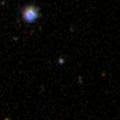The colors of the sources close to the SNR are:
275.23312 -14.32476 (the further source)
IR:
closest source was 2.039001" away , at RA: 275.233684, DEC: -14.324909, with theses colors: j_mag:12.093, h_m: 11.612, k_mag: 11.402, and j-h=0.4810, h-k=0.2100, j-k=0.6910
errors were: j_msigcom:0.023, j_snr:323.8, h_msigcom:0.028, h_snr: 94.2,k_msigcom: 0.030, k_snr: 91.3- snr's are insanely high, unfortunately, not sure if this debunks any of this....
FLAGS: ph_qual: AAA, rd_flg:222, bl_flg: 111, cc_flg:000
optical:
closest source was 2.052775", at RA: 275.233659, DEC:-14.324989, with these colors, b1_mag: 15.48, r1_mag: 13.54,
errors: e_ra: 82, e_dec:69, there were no flags
For 275.23763 -14.33405 (the source closer, to the right side of the snr flux peak),
In the IR:
There were two sources found within a radius of 5"
The closest was 1.079200" away, RA: 275.237796, DEC: -14.334303, with these colors: j_mag:16.008, h_m: 14.235, k_mag: 12.635, j-h=1.7730, h-k=1.600, j-k=3.37300
errors were: j_msigcom:0.096, j_snr:8.8, h_msigcom:0.075, h_snr: 8.4, k_msigcom: null, k_snr: null
FLAGS: ph_qual: BBU, rd_flg:220, bl_flg: 110, cc_flg:0c0
No optical counterpart
At the SNR peak, 275.24215 -14.33351, though no IR counterpart, there was an optical counterpart, with these properties:
b1_mag: null, r1_mag:18.83,
errors: e_ra: 10, e_dec:999, no flags.








 border="0" alt=""id="BLOGGER_PHOTO_ID_5239658620774324546" />
border="0" alt=""id="BLOGGER_PHOTO_ID_5239658620774324546" />











 I'm not quite sure what conclusions to draw from looking at spectra, looks like emission lines, which would also indicate a QSO- I know we are looking for a black body with lines indicating helium, but I'm not sure if these spectra are normalized in some way (this is probably very obvious but I'm not very used to interpreting spectra...) Also, this is kindof irrelevent if this is a galaxy, again.
I'm not quite sure what conclusions to draw from looking at spectra, looks like emission lines, which would also indicate a QSO- I know we are looking for a black body with lines indicating helium, but I'm not sure if these spectra are normalized in some way (this is probably very obvious but I'm not very used to interpreting spectra...) Also, this is kindof irrelevent if this is a galaxy, again.